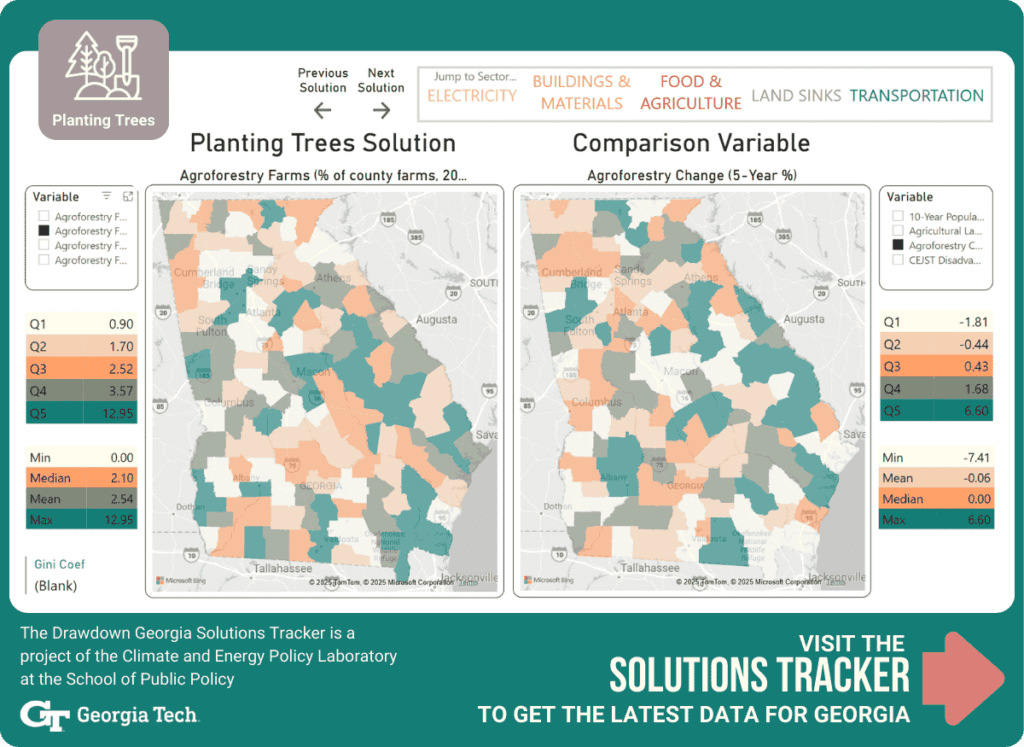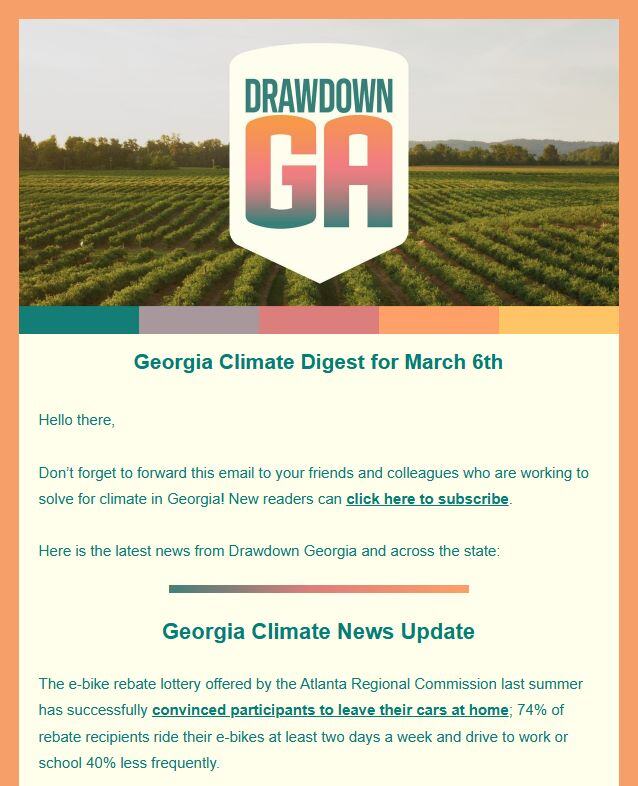The Benefits Of Tree Planting
Tree planting, also known as afforestation, is the process of restoring the benefits of forests in places that are no longer forested. This includes planting trees on degraded agricultural or pasture lands and planting in urban areas. Forests sequester carbon in trees, soil, and other vegetation, even in urban areas.
Forests are the main natural terrestrial carbon or land sink on the planet. According to the USDA, 11.1% of the land in our state was used as cropland in 2012 -- a total of about 4.19 million acres. Conservatively, if 10% of Georgia’s current croplands are afforested with mixed tree species, equivalent to 0.42 million acres, this would increase CO2 uptake and carbon storage by 0.46 Mt CO2 per year. However, if instead these lands were planted with native trees such as loblolly pine (Pinus taeda), this CO2 uptake rate would increase to over 1.8 Megatons (Mt) CO2 per year by 2030.
When carbon storage in soils is also considered, the carbon sequestration would increase further. For each mixed species versus loblolly scenario, the estimated carbon sequestration refers to CO2 stored in both trees and in soils.
The mixed tree species scenario at a 10% crop and pasture planting level would sequester 5.3 Mt CO2 in 2030.
The Loblolly Pine scenario with a 10% crop and pasture planting level would sequester 7.8 Mt CO2 in 2030. Also see the discussion of the Forest Management solution, which overlaps with this solution’s estimated carbon sequestration.
Access Planting Trees Resources from Drawdown Georgia
Market Readiness and Available Technology
Planting trees on formerly forested lands that are now developed (urban, suburban) or used for agricultural pastures would benefit both the carbon sequestration potential and protect humans and livestock from intense summer heat via shade. Georgia is the number one forestry state in the nation and has multiple urban tree planting programs, such as Trees Atlanta.
In 2023, the Biden administration allocated $1 billion in grants for urban tree planting projects across the country in order to combat climate change and the urban heat island effect. Information about this grant is subject to change.
Planting Trees as a Climate Solution in Georgia
The Drawdown Georgia research team estimates that Georgia could reduce emissions by one megaton (Mt) of CO2e by planting 7% of current pasture lands with mixed hardwoods including loblolly (Pinus taeda), shortleaf (P. echinata), and longleaf (P. palustris) pine tree species.

What is the Carbon Emissions Reduction Potential by 2030?
Achievable reduction potential is derived by taking the technical reduction potential, outlined below, and developing a more realistic forecast that takes current rates of deployment, market constraints, and other barriers into consideration.
For planting trees, the Drawdown Georgia research team has calculated the achievable reduction potential to be 1.73 Mt of CO2e.
What Is the Upper Limit of Carbon Emissions Reduction Potential?
Technical reduction potential reflects the upper limit of emissions reductions for this solution without regard to the constraints that exist in the real world, such as economic or political considerations.
For planting trees, the Drawdown Georgia research team has calculated the technical reduction potential to be 14.3 Mt.
Progress on Planting Trees in Georgia

Trees Columbus received a $900,000 grant to plant 500 trees between 2024 and 2028 in overburdened and underserved parks that haven’t experienced tree restoration and proper tree planting in over 60 years.
The funding is part of the second-largest Trees Across Georgia grant from the Georgia Forestry Commission, funneled down from the Inflation Reduction Act, which provided $1.5 billion for state and private forestry conservation programs. Information about grant funding is subject to change.
How Reliable Is Our Estimate For This Drawdown Georgia Climate Solution?
Because Georgia is the top forestry state in the United States, and agriculture is the most important business in the state, we have ample local experience, expertise, and data on planting trees. Afforestation data can be easily estimated using the National Land Cover Database, which is available free of cost to users.
Cost Competitiveness Factors
Forestry is one of Georgia’s biggest economic sectors. For planted pines with forestry management, the cost of this above-ground carbon storage solution is about $3.50 per ton of CO2. The cost for unmanaged forests is essentially $0 per ton of CO2.
Beyond Carbon Attributes
Reforesting formerly forested lands provides biodiversity conservation, jobs, and
freshwater quality benefits. Environmental benefits of planting trees include improved air quality through a reduction in particulate matter.
Afforestation provides habitats for wildlife, further benefiting local ecosystems, and may also provide social-economic opportunities through timber production, recreation, and tourism. Since these solutions are often concentrated in rural areas, the environmental and social benefits are often accessible to lower-income groups, providing improved mental/physical health from outdoor recreational opportunities.
The rural land available for farming may be reduced, but may also be supplemented by farming tree products, which can lead to economic benefits for landowners, increasing sustainable income.
Afforestation also has the potential to cut farmers’ costs by reducing the need for feed, fertilizer, and herbicides, and can improve the fertility of soil with clay content. However, costs to establish and maintain the solution–for example, increased water usage to plant trees, pruning, and root damage to infrastructure–should be considered.
Economic barriers to planting trees may be an issue for low-income farmers. Shifting away from traditional farming routines is a potential issue for new solutions that are not typically custom for farmers, and therefore may not be easily adopted. See also Forest Management.




